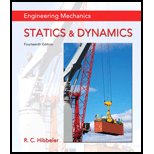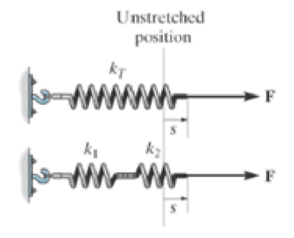
Concept explainers
Determine the stiffness kT of the single spring such that the force F will stretch it by the same amount s as the force F stretches the two springs. Express kT in terms of stiffness k1, and k2 of the two springs.

The stiffness
Answer to Problem 17P
The stiffness
Explanation of Solution
Given information:
- The force F will stretch it by the same amount s as the force F stretches the two springs.
Write the magnitude of force exerted on a linearly elastic spring in an unstretched position.
Here, the stiffness of the spring is k and the stretch of the spring is s.
Write the stretch value for two springs.
Here, the stretch of the first spring is
Write the equation for the magnitude of force exerted on a linearly elastic spring 1.
Here, the stiffness of the spring 1 is
Write the equation for the magnitude of force exerted on a linearly elastic spring 2.
Here, the stiffness of the spring 2 is
Conclusion:
Substitute
Thus, the stiffness
Want to see more full solutions like this?
Chapter 3 Solutions
Engineering Mechanics: Statics & Dynamics (14th Edition)
- Determine the magnitude of the WEIGHT of the box (in Newtons) if it is known that the tension in the AC cable is 3629.75 Newtons. B y -1.21m -1.37m 1.52m D 2.28m 1.02m- Xarrow_forwardThe two flexable cables A and N are 220-lb, When a particle is in equilibrium under the action of forces, Fx=0 and Fy = 0. To solve for the unknown forces, resolve each force into the x and y components and set each equal to zero. Then solve the simultaneous equations to find the unknown F’s. determine the tension in each cable.arrow_forwardDetermine the force in cable BC and the spring stiffness (k) in N /m when the spring is held in the position shown. The force in cable BD is 150 N and the spring has unstretched length of 400mm. 600mm 200mm 800mm 300mmarrow_forward
- Determine the horizontal and vertical components of force at each pin. The 600-N force is applied to the pin.arrow_forwardThe boom supports the two vertical loads. Neglect the size of the collars at D and B and the thickness of the boom, and compute the horizontal and vertical components of force at the pin A and the force in cable CB. Set F1 = 810 N and F2 = 320 N . Pt A. : Determine the horizontal and vertical components of force at the pin A Pt B: Determine the force in cable CB.arrow_forwardThe pipe is stuck in the ground so that when it is pulled upward the frictional force along its length varies linearly from zero at B to fmax (force/length) at C. The pipe has a length L, cross-sectional area A, and the material from which it is made has a modulus of elasticity E. Determine the initial force P required to pull the pipe out. Express your answer as an expression in terms of the variables f, L, A and E and any necessary constants.arrow_forward
- Also determine the magnitude of the force at A and the magnitude of the force at B. Express your answer in units of N.arrow_forwardDetermine the horizontal and vertical components of force that pins A and B exert on the two-member frame. Set F = 485 N .arrow_forwardThe guy wires AB and AC are attached to the top of the transmission tower. The tension in cable AB is 7.3 kN. Determine the required tension T in cable AC such that the net effect of the two cables is a downward force at point A. Determine the magnitude R of this downward force.Assume a = 41 m, b = 48 m, c = 29 m, and d = 35 m.arrow_forward
- Q1) A man is pulling a spring of stiffness coefficient 8 Ib/in by his hand with the entire arm held horizontally rotating about shoulder joint O; this force acts at the 21° angle is shown. Determine the force exerted by the deltoid muscle on the upper arm at A and x- and y- components of the force reaction at the shoulder joint. The weight of the upper arm Wu = 4.1 Ib, the weight of the lower arm W1 2.4 Ib, and the weight of the hand WH= 0.9 Ib; all these weights act at the locations shown in the figure. the spring extended 1 in only as shown in figure 1. A tensile force in the deltoid muscle prevents the arm from A- 8 Ibin Equilibrium x-1 in Deltoid muscle Fo A YW, YW -5.2 16.5 25.4 Figure 1arrow_forwardA bicyclist applies a 40-N force to the brake lever of her bicycle as shown. Determine the corresponding magnitude of tension force T transmitted to the brake cable. Neglect friction at the pivot O. Express your answer in units of N. 19 mm- T 88 mm 40 Narrow_forwardForces F1 and F2 act on the bracket as shown. Find R. F = 100 N 30 20 F2 = 80 Narrow_forward
 Elements Of ElectromagneticsMechanical EngineeringISBN:9780190698614Author:Sadiku, Matthew N. O.Publisher:Oxford University Press
Elements Of ElectromagneticsMechanical EngineeringISBN:9780190698614Author:Sadiku, Matthew N. O.Publisher:Oxford University Press Mechanics of Materials (10th Edition)Mechanical EngineeringISBN:9780134319650Author:Russell C. HibbelerPublisher:PEARSON
Mechanics of Materials (10th Edition)Mechanical EngineeringISBN:9780134319650Author:Russell C. HibbelerPublisher:PEARSON Thermodynamics: An Engineering ApproachMechanical EngineeringISBN:9781259822674Author:Yunus A. Cengel Dr., Michael A. BolesPublisher:McGraw-Hill Education
Thermodynamics: An Engineering ApproachMechanical EngineeringISBN:9781259822674Author:Yunus A. Cengel Dr., Michael A. BolesPublisher:McGraw-Hill Education Control Systems EngineeringMechanical EngineeringISBN:9781118170519Author:Norman S. NisePublisher:WILEY
Control Systems EngineeringMechanical EngineeringISBN:9781118170519Author:Norman S. NisePublisher:WILEY Mechanics of Materials (MindTap Course List)Mechanical EngineeringISBN:9781337093347Author:Barry J. Goodno, James M. GerePublisher:Cengage Learning
Mechanics of Materials (MindTap Course List)Mechanical EngineeringISBN:9781337093347Author:Barry J. Goodno, James M. GerePublisher:Cengage Learning Engineering Mechanics: StaticsMechanical EngineeringISBN:9781118807330Author:James L. Meriam, L. G. Kraige, J. N. BoltonPublisher:WILEY
Engineering Mechanics: StaticsMechanical EngineeringISBN:9781118807330Author:James L. Meriam, L. G. Kraige, J. N. BoltonPublisher:WILEY





